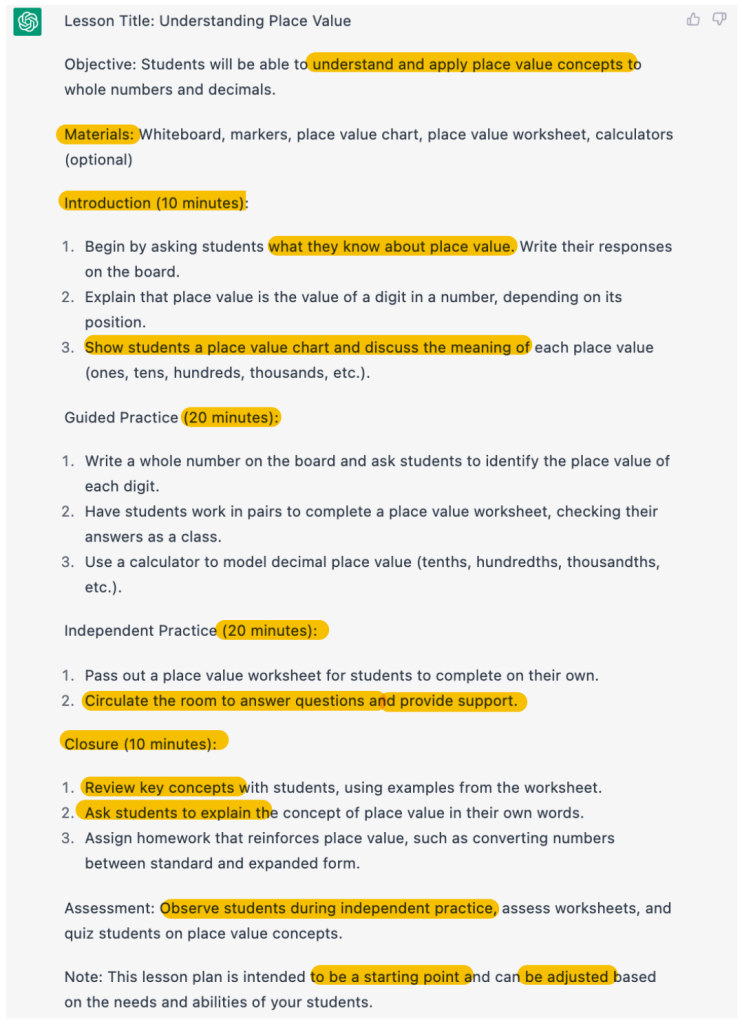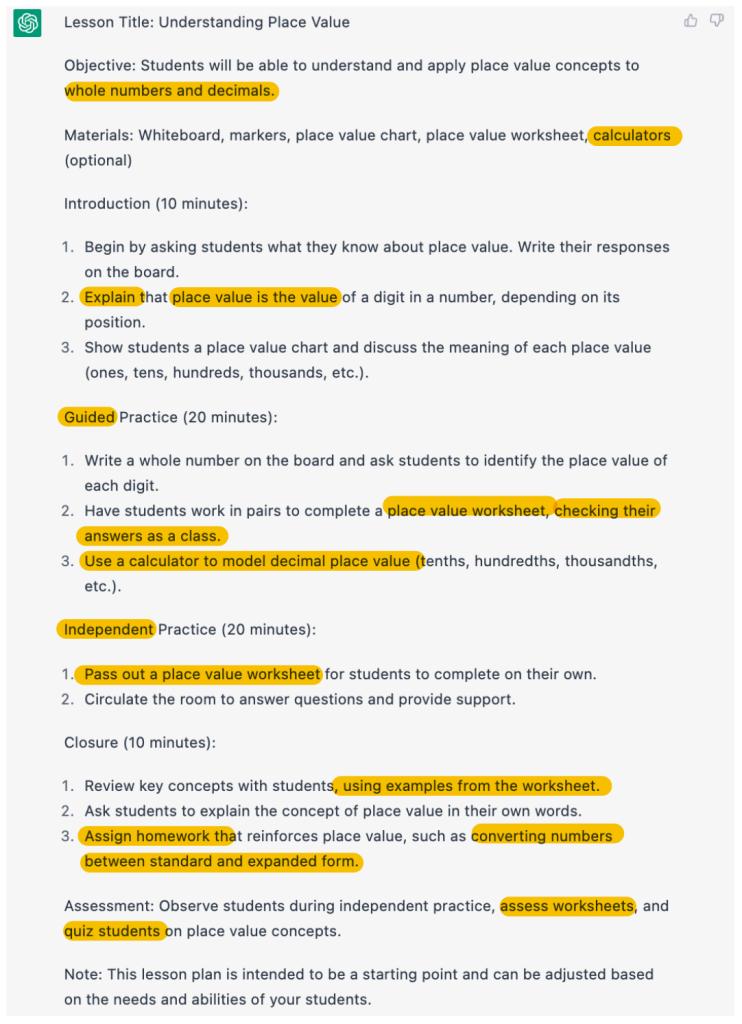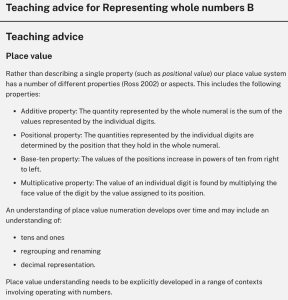Well technology has taken it’s next leap with the launch of ChatGPT Open access AI (Artificial Intelligence). It’s currently a research release to gain feedback on AI’s ability to ‘benefit all humanity’. I’m not here to make any political or controversial statements about AI, but I was super intrigued about what it could potentially offer. As both a teacher and a uni lecturer there could be many pros and cons to ChatGPT’s AI – from teachers using it to write a parent welcome speech for assembly, to students using it to write essays for them. Whether it’s good or bad, it’s here to stay! If you’ve never heard of ChatGPT or AI, follow the link above to learn more; even if it’s just for the fun or getting it to write weird creative stories about tiny play-dough dinosaurs taking over the world!
Apart from wondering how good or bad it will be at writing assignments for my students, I was curious about how it would go at writing a mathematics lesson plan. This idea was sparked by a comment on Twitter by James Russo about the fact that the Victorian gov have banned ChatGPT in schools.
It does seem a bit like blocking your ears and screaming 'I can't hear you' at the top of your lungs... Perhaps not the most thoughtful and mature response...
— James Russo (@surfmaths) February 3, 2023
I don’t claim to be an ‘expert’ teacher, far from it, but as someone who works in mathematics education all day everyday, I felt that although the ‘average’ person (or student-teacher or teacher) may read the plan the AI produces and think it’s ok (or great), a more keener eye and a deeper inspection may detect some fundamental pedagogical flaws–and I was not disappointed! I asked it to write a lesson plan for understanding place value. This is the bread-and-butter of all primary teachers’ classroom lessons, particularly in the first Term of the year. Below I’ve highlighted aspects of the lesson to discuss; first the good, then the bad.
Positive aspects of the AI’s lesson plan
- The lesson has an objective – all good lesson plans either have a goal, objective or learning intention that the teacher has developed based on both the content of the curriculum and the students’ needs. The objective mentions understanding and application, both of which are important, knowing the concept and what do do with it.
- The lesson plan includes materials, and most are appropriate materials that I would use to teach place value. The inclusion of place value charts and whiteboard markers indicate that informal recording will be involved.
- The lesson starts with asking students what they already know, this is a great way to launch your lesson to discover prior conceptual understanding and any gaps or misconceptions students may have.
- There is structure to the lesson plan, and most importantly there is a conclusion section. Walker (2014) states that an effective lesson closure “lies in planning for worthwhile discussion” (p. 629). The AI’s closure includes revising the key concepts of the lesson and students explaining their knowledge which is a real strength.
- The lesson plan mentions assessment, and the assessment strategies are ongoing in nature. The lesson includes the teacher roaming the room which is an opportunity for in-the-moment assessing, and states that the teacher should be observing students as they work.
- The plan acknowledges that adjustments for differentiation may need to be made and that the lesson is just a starting point for further exploration of the concept.
Negative aspects of the AI’s lesson plan
- The lesson plan has an objective, however, it involves at least two concepts of place value–whole number and decimal place value systems. If I had stated the age-range as about Grade 4 or above, this probably would be ok as this is where we begin to extend the place value system to decimals. But for younger grades, focusing on one, say understanding whole number place value, would be more appropriate.
- The lesson lacks depth of knowledge by the writer (the AI) regarding MCK (mathematical content knowledge). This is where I thought the AI’s ability to write a ‘good’ lesson may break down. Although the position of the digit is important, and related to place value, it is not the totality of the concept of place value (for a good description of place value see the image below).
- The lesson lacks depth of knowledge by the writer regarding PCK (pedagogical content knowledge). Again, this is where I expected the AI to break down [note: I’m glad about this, teaching is not easy, it’s a profession, and requires not only a university degree but a lifetime of focusing on continually improving practice through study and experience]. At a surface level the plan looks good, it has all the essential ‘features’ but they are just that, surface-level, superficial. The lesson’s structure as I mentioned has some good aspects, however, the MGI (modelled-guided-independent) lesson model is outdated and does not work well in mathematics lessons. There is currently a welcome move from ‘I do, we do, you do’ to the ‘launch, explore, summarise’ model (Sullivan et al., 2016). Explicit teaching is still important, and equally as valid is student inquiry. However, the focus is on the students and drawing out what they know, not just ‘filling’ them with information. Russo and Hopkin’s (2017) study on task-first vs teach-first is well worth the read. The fact that fairly early in the lesson there is a focus on the teacher ‘telling’ (explaining) the concept – not building off what the students might have provided to the first question is problematic.
- Although technology use in the mathematics classroom is encouraged, there is no reasoning to support the use calculators in this lesson nor does it describe a pedagogical reason to use them – students are simply typing numbers with decimal points.
- There is a lack of depth to what the students are doing. The place value charts are in the materials list but not utilised well in the lesson (apart from the teacher showing them). There is no focus on the relationship between the ones, tens and hundreds or the related language. There is a heavy focus on ‘worksheets’, ‘answers’, ‘checking’ and ‘homework’. Unfortunately, this is probably what most adults think about maths classes so it’s not surprising that’s what the AI drew upon.
Teaching Advice for Stage 1: Representing whole numbers B (available from NESA’s K-6 Mathematics syllabus)
So where does that leave us? How good is AI at writing a maths lesson? If this AI was in a first-year primary education class at uni, they’d probably pass with this lesson plan! It’s pretty basic and misses many points a quality mathematics lesson plan has, but it’s a start. In my mind we are still light years away from having AI that has the depth of mathematical content knowledge and pedagogical content knowledge to write quality lesson plans for us. Also, the real-life classroom experiences and nuances of in-the-moment teaching and learning are what make teachers best-placed to be writing their own lesson plans. This is not to say that AI is not useful, the potential for using AI in many aspects of education is promising. But perhaps for now, it might be best to leave AI solving the maths problem lessons than writing them!
References
https://openai.com/blog/chatgpt/
Lappan, G., Phillips, E. (2009) A Designer Speaks. Educational Designer, 1(3). Retrieved from: http://www.educationaldesigner.org/ed/volume1/issue3/article11
Russo, J., & Hopkins, S. (2017). How Does Lesson Structure Shape Teacher Perceptions of Teaching with Challenging Tasks?. Mathematics Teacher Education and Development, 19(v1), 30-46.
Sullivan, P., Borcek, C., Walker, N., & Rennie, M. (2016). Exploring a structure for mathematics lessons that initiate learning by activating cognition on challenging tasks. The Journal of Mathematical Behavior, 41, 159-170.
Sullivan, P., Bobis, J., Downton, A., Feng, M., Hughes, S., Livy, S., … & Russo, J. (2021). An instructional model to support planning and teaching student centred structured inquiry lessons. Australian Primary Mathematics Classroom, 26(1), 9-12.
Walker, N. (2014). Improving the Effectiveness of the Whole Class Discussion in the Summary Phase of Mathematics Lessons. Mathematics Education Research Group of Australasia.








